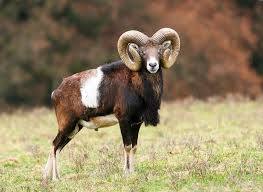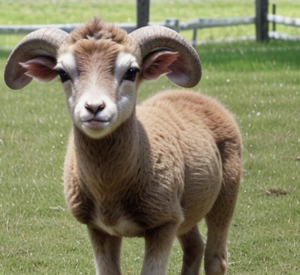Birth of new Mouflon Lambs in the New Forest Wildlife Park (NFWP)
 Over the course of this month, the New Forest Wildlife Park (NFWP) was very excited to announce the birth of five rare, European Mouflon Lambs. Arriving on the 5th, 9th and 11th of April, the NFWP say these births are a testament to the park’s hard work and dedication to the conservation of this: “Unique wild sheep species”.
Over the course of this month, the New Forest Wildlife Park (NFWP) was very excited to announce the birth of five rare, European Mouflon Lambs. Arriving on the 5th, 9th and 11th of April, the NFWP say these births are a testament to the park’s hard work and dedication to the conservation of this: “Unique wild sheep species”.
The European mouflon, a wild sheep with a fascinating history, is descended from an ancient form of domestic sheep. Once confined to the rugged landscapes of the Mediterranean islands of Corsica and Sardinia, these elusive creatures were not always wild. Thousands of years ago, they likely shared a common ancestor with the familiar farmyard sheep we know today. However, the mouflon’s story took a unique turn. They either escaped domestication or were reintroduced to the wild, eventually establishing themselves as a distinct subspecies on these Mediterranean islands. However, their island existence wasn’t to last. In a move that would forever alter their distribution, European mouflon was later introduced to various regions across Europe, primarily for hunting purposes.
The animal Manager at the New Forest Wildlife Park said: “We are incredibly excited to welcome these new mouflon lambs, as one of only two UK collections to showcase mouflon, we play an important role in educating the public about this fascinating species and contributing to their ongoing conservation.” The NFWP currently herds one ram, four ewes, and their new lambs.
Visitors of the park will be able to see the ram’s majestic horns, signifying its maturity and dominance, while the ewes will typically have smaller horns, or sometimes none at all. The mouflon lives in small herds, led by an older, more intelligent ewe, whilst rams often form separate groups outside of the October/November rutting season. Then in March/April times, after a five-month gestation period, the ewes give birth to one or two lambs, nursing them for around six months.
A spokesperson at the New Forest Wildlife Park said: “While the IUCN classifies European mouflon as feal, the NFWP recognises their educational value and actively participates in breeding programs.” They added: “Threats like habitat loss, poaching, and disease transmission from domestic livestock highlight the need for ongoing conservation efforts”.
In April 2022, The New Forest Wildlife Park hit record-breaking births for mouflon, with 14 lambs being born, which only goes to further highlight their efforts towards the conservation of endangered animals.
For those wanting to advertise their businesses to the tremendous crowd of area’s residents or tourist visitors, kindly think about publicising your organisation with the New Forest Advertiser. This highly regarded media distribution arrives with a wide and very quickly growing local readership and serves as an important asset for tourist guests from outside the area, arranging their holidays within the district.
“By showcasing mouflon, we can educate our visitors about the challenges facing wild sheep populations and the importance of responsible wildlife management, it’s heart-warming to see our herd expanding and know we’re making a difference.” Explains Keeper Jenn Rawson.
The New Forest Wildlife Park are encouraging visitors to come and see their new lambs and to discover the importance of mouflon conservation.
A Haven of Nature in Hampshire
Nestled within 50 acres of mature, ancient New Forest woodland, the park is a sanctuary for a diverse range of animals and a paradise for nature enthusiasts. The park is home to a variety of species, from the playful otters, including the endangered giant otter family, to the howling wolves, and the elusive lynx. Visitors can also spot pine martens, polecats, owls, ferrets, and more.
The park is not just about observing wildlife; it’s about immersing oneself in the world. Visitors can follow the woodland trails and walk with the wallabies, see the European bison, and wild boar. The park also offers a unique opportunity to meet the friendly deer in their deer encounter enclosure.
For those interested in conservation, the park is involved in several projects, including breeding programmes for endangered native species such as Scottish wildcats, water voles, and harvest mice. The park is recognized as the UK’s leading institution in the rescue and rehabilitation of sick, injured, and orphaned wild otters, along with the rehabilitation of other wildlife such as owls, deer, and foxes.
The Wildlife Park is not just about wildlife; it’s also about fun and learning. It boasts two amazing playgrounds for children under 6 and over 6, making it a perfect destination for family outings. There are daily keeper talk feeding sessions and special events throughout the year.
The park also offers Keeper Experiences, where visitors can get even closer to the animals. These experiences, which need to be booked in advance, allow visitors to engage with experts, discover animal care secrets, and contribute to conservation.
The Park is more than just a wildlife park. It’s a place where family fun, conservation, and nature come together. It’s a place where extraordinary encounters await as you reconnect with the natural world. Whether you’re seeking adventure, education, or a relaxing day out, visiting the New Forest Wildlife Park is a must when in Hampshire.


